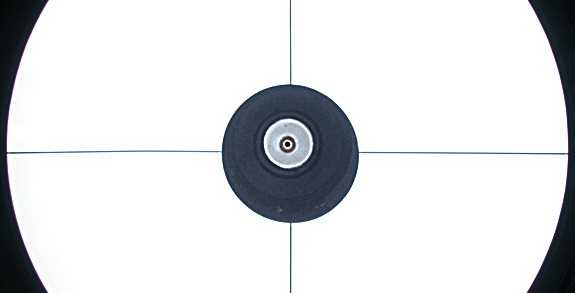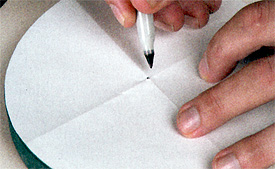
There’s no getting around the fact that collimating your reflector telescope (Dobsonian or otherwise) is much easier when the centre of the primary mirror is marked with a paper doughnut. Thankfully, these days a good number of commercially made telescopes come with their mirrors pre-marked. But if your scope isn’t so equipped, don’t worry — the procedure for adding a centre doughnut isn’t difficult. In fact, the hardest part might be convincing yourself that you can take out the primary mirror without inviting disaster.

Step #1: Remove the primary mirror.
Your telescope’s main mirror is housed in a cell that normally attaches to the tube with a few small screws. Before removing these, stick a small strip of masking tape to the mirror cell and tube to index it so that you can put it back together the same way. Sometimes the cell fits into the tube rather snugly, so use care.
Step #2: Make a mirror mask.
To do this, carefully place the mirror shiny side down on a clean sheet of paper and trace its outline with a pencil. Cut out the circle, then carefully fold it into quarters to find its exact centre. Make a hole there, about 1/10-inch across. Alternatively, you could measure the diameter of your mirror and use a compass (set to ½ the mirror’s diameter) to draw a circle on a blank piece of paper — the pinprick of the compass point defines the centre of the circle.
Step #3: Dot the centre of the mirror. 
Gently lay the paper circle onto the face of the primary mirror so that its edge aligns with that of the mirror. Using a fine-tip permanent marker, make a mark on the mirror’s centre.

Step #4: Add the “doughnut.”
This step is necessary because seeing a tiny dot while looking in your scope’s focuser is very difficult — especially in the dark. Position a notebook-paper reinforcement ring (available at any stationary store) so that it’s concentric with your centre mark. Once the doughnut is in the right place, push down on it with the eraser end of a pencil to stick it down permanently. Since the doughnut hides in the shadow of the secondary mirror, it doesn’t affect the view.
Put the mirror back in the scope the same way it came out, and you’re done!
Did you find this article interesting or helpful? If so, consider using this link the next time you shop at Amazon.com. Better yet, bookmark it for future use. Thanks to Amazon’s associates program, doing so costs you nothing yet helps keep this site up and running. Thanks!
Note: This is a revised version of an article that originally appeared in NightSky magazine.
